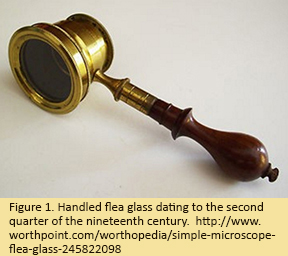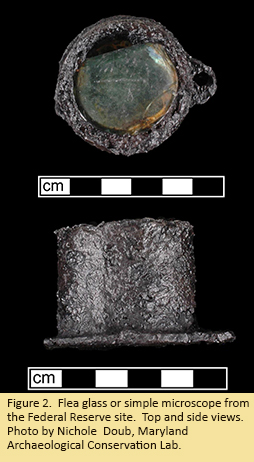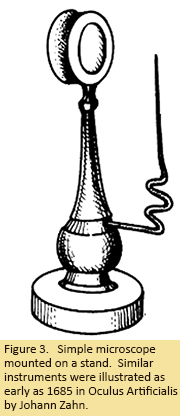Curator's Choice 2017
Under the Microscope: A Nineteenth-Century Flea Glass
February 2017
By Patricia Samford, MAC Lab Director
 "The eye of a human being is a microscope, which makes the world seem bigger than it really is." Khalil Gibran (1883-1931)
"The eye of a human being is a microscope, which makes the world seem bigger than it really is." Khalil Gibran (1883-1931)
Nineteenth-century physicians often found that they needed more than just the naked eye to assist them with offering quality health care to their patients. Using magnifying devices, like this rudimentary microscope known as a flea glass (Figure 1), allowed them to gain a better view of wounds or for routine examinations of ears, eyes and throats.
Invented in the 1500s, flea glasses were used primarily for studying insects and other small life forms (hence the name), rather than for medical purposes. A small, convex lens held nearest to the eye and a larger, flat lens at the opposite end of a short metal tube allowed for magnification ranges of 6x to 10x.
 The lenses and iron fittings of a flea glass or similar simple microscope were recovered from a circa 1850 to 1870 privy excavated at the Federal Reserve site (18BC27) in Baltimore (Figure 2). This
The lenses and iron fittings of a flea glass or similar simple microscope were recovered from a circa 1850 to 1870 privy excavated at the Federal Reserve site (18BC27) in Baltimore (Figure 2). This  magnifying instrument may have been mounted on a stand, similar to the instrument shown in Figure 3 (Bradbury 1968). A medical use for this scientific instrument was assumed because the privy fill also contained a number of other artifacts relating to medical care—a mortar and pestle, a salve jar, a pill tile, a leech jar, a number of medicine bottles and a possible stethoscope.
magnifying instrument may have been mounted on a stand, similar to the instrument shown in Figure 3 (Bradbury 1968). A medical use for this scientific instrument was assumed because the privy fill also contained a number of other artifacts relating to medical care—a mortar and pestle, a salve jar, a pill tile, a leech jar, a number of medicine bottles and a possible stethoscope.
Documentary records indicate that the privy was located near the Southern Dispensary, a branch of the Baltimore General Dispensary. A dispensary supplied free medicine and health care for citizens who could not otherwise afford medical services. The Southern Dispensary, funded by charitable donations and a small appropriation from the city, was incorporated in 1847 and remained in operation until at least 1889 (Woods 1847; Register 1890). The dispensary offered both clinic and in-home health care (Polk 1888).
With large populations living in close proximity, it was critical for cities to provide medical services. At various times during the eighteenth and nineteenth centuries, infectious diseases, including tuberculosis, cholera, yellow fever and smallpox, struck Baltimore (Mdmedicine 2017). Clinics, like the Southern Dispensary, played key roles in treating infected individuals and preventing widespread epidemics.
| References |
|
| Bradbury, S. |
| 1968 |
The Microscope Past and Present. Pergamon International Popular Science Series. Pergamon Press, Ltd., Oxford. |
|
| Mdmedicine |
| 2017 |
Epidemics in Maryland. Website accessed January 13, 2017. http://mdhistoryonline.net/mdmedicine/index.cfm?action=epidemics |
|
| Polk, R. L. |
| 1888 |
The Medical Directory and Register for Baltimore, Washington, Maryland and District of Columbia . R. L. Polk & Co., Baltimore. |
|
| Register |
| 1890 |
Annual Reports of the Register of the City and the Commissioners of Finance. John Cox, Printer, Baltimore. |
|
| Woods, John W. |
| 1847 |
The Act of Incorporation and By-laws, of the Southern Dispensary of Baltimore: Together with a List of Officers for 1847. Baltimore |
|
| Zahn, Johann |
| 1685 |
Oculus Artificialis Teledioptricus Sive Telescopium. W�rzburg, Germany. |
|